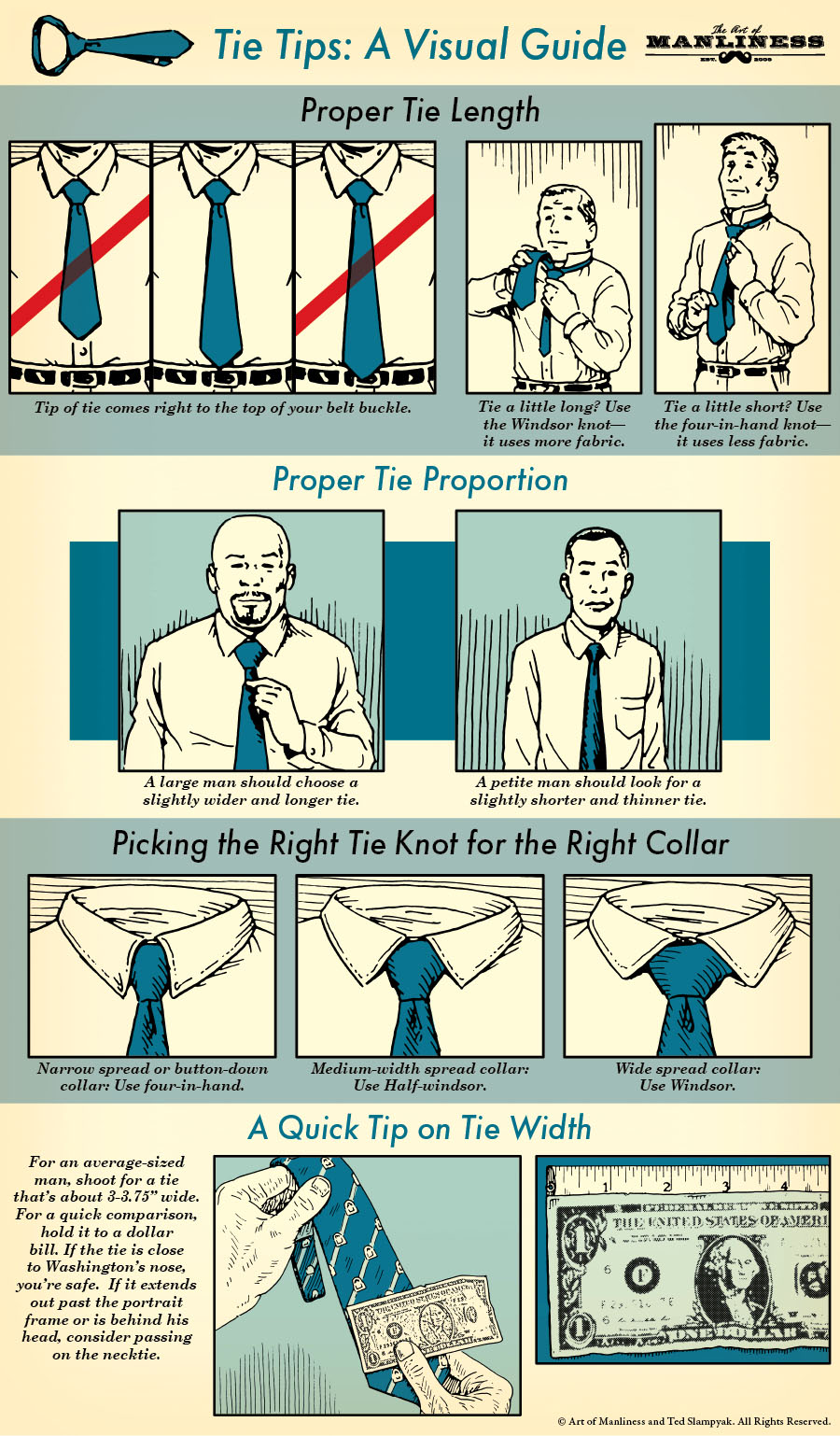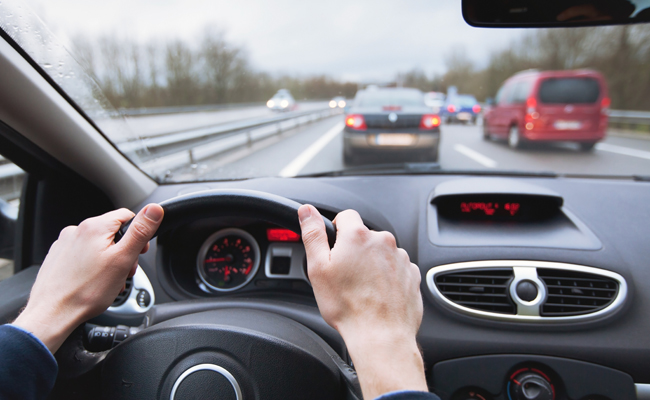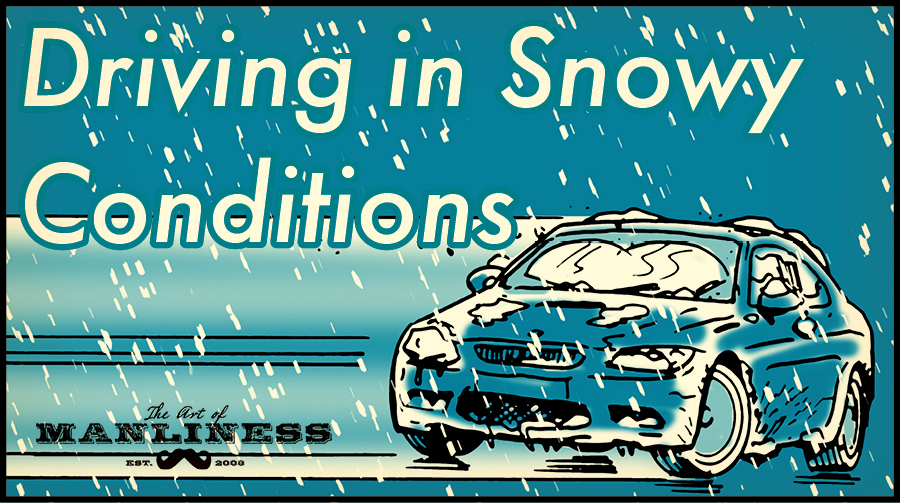
With our archives now 3,500+ articles deep, we’ve decided to republish a classic piece each Sunday to help our newer readers discover some of the best, evergreen gems from the past. This article was originally published in December 2017.
While busy airports tend to get all the attention around the holiday travel season, the highways and byways are actually far more trafficked. Of long-distance travelers — those going 50 miles or more — over 90% are getting to where they’re going by car. Thanksgiving and Christmas/New Year’s are in fact the most heavily trafficked times of year on America’s roads.
While it’s wonderful that folks are traveling to spend time with friends and family, it’s also an unfortunate time of year to be on the roads in certain parts of the country. Icy streets and snowstorms can quickly change a pleasant drive with the family into a stressful and truly dangerous situation, especially if one isn’t familiar with winter driving tactics and practices; it’s a whole different game than driving on dry pavement.
So whether you’ll be passing through conditions on the way to Grandmother’s house that you don’t normally encounter in your home state, or you’ve recently moved to a snowy place and are getting the feel for driving in your first winter there, be sure to acquaint yourself with how to navigate this cold and slick season. Below I offer a primer on this subject, based on input from experts, as well 15 years of my own experience driving in wintry conditions in Minnesota, Iowa, and Colorado.
Before Driving
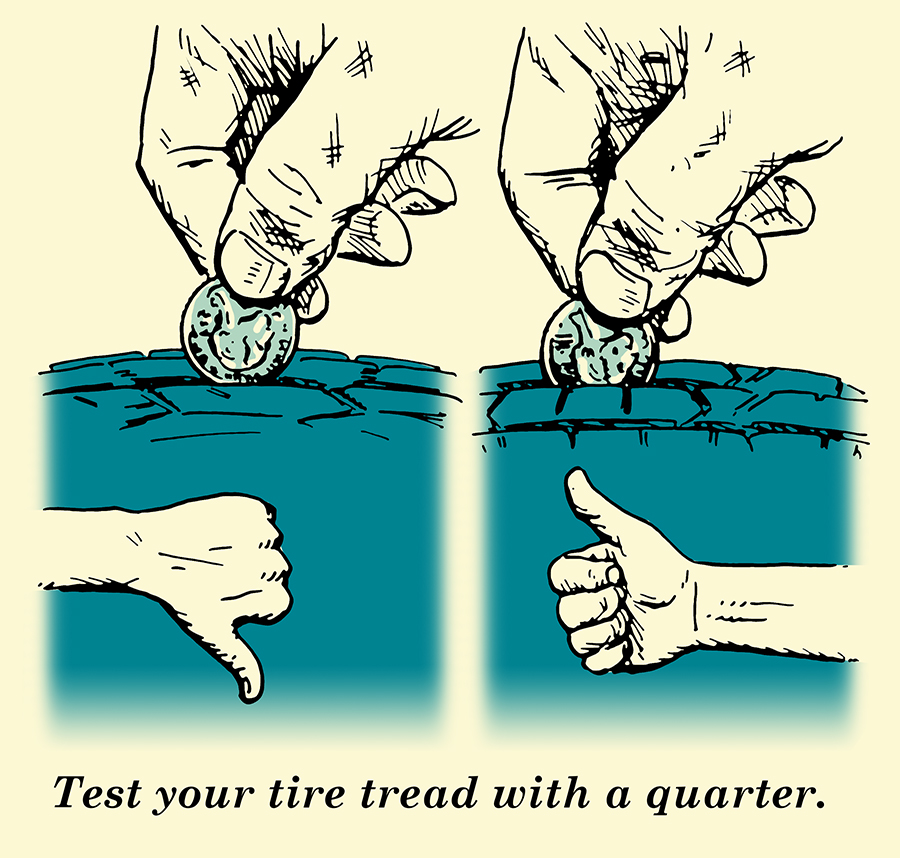
Ensure proper tire tread. One of the most important things you can do before getting behind the wheel in snowy conditions is to ensure your tires have enough tread to grip the road/snow. While proper tire inflation is also important (even though myths about intentionally underinflating in winter persist, don’t do that; it puts too much pressure on the tire), tread depth is more so. In some states (including my home of Colorado), you can actually get fined in the winter for having balding tires.
You should have at least 1/8” of tread. A quick way to measure this is to simply use a quarter, with George Washington’s head pointing down. Place the quarter in the tread, and if the top of his head is covered, you’re also covered. If the top of his head is visible (at any point around the tire — test multiple points) it’s time for new tires, and ASAP. More winter accidents are caused by poor tread than anything else. In recent years, Colorado State Patrols have tried to underscore this point by measuring tire treads at ski area parking lots and handing out fines if treads are less than that 1/8” threshold.
You’ll see some guidelines saying that 1/16” is okay (which would be passable using the Lincoln penny test), but newer standards and research shows that it may already be too late at that point — especially in mountain environs.
Don’t hesitate to delay your errands/road trip if needed. Pay close attention to weather forecasts. If it’s a week out and the weather looks spotty, no need to postpone plans yet. But check daily what the reports look like, and if it gets to be 1-2 days beforehand and the forecast still calls for blizzard conditions, don’t hesitate to postpone. It’s a hassle, of course, but far better to be safe than sorry. And even though weather forecasting is an inexact science, when it’s just a day or two out they’re more likely than not to be right. You also really just need to know your own confidence levels. Growing up in Minnesota, I have years of winter driving under my belt, so it takes quite a bit to keep me off the road. I have no judgment, though, for someone from a warmer locale canceling plans because they don’t want to be on the snowy roads. Again, use your head, and repeat to yourself over and over that it’s far better to be safe than sorry.
Here’s a pro tip: Use national weather services vs. local reports. In his book The Signal and the Noise, statistician Nate Silver researched this topic and found that local meteorologists tend to exaggerate forecasts (albeit unintentionally — probably) and make things seem just a little worse than what the National Weather service might say. Why does this happen? Because a poor weather forecast is going to garner better TV ratings than a good one. My go-to is weather.gov online and Wunderground on the phone.
Keep winter emergency supplies in the car. While there are some things you should always have in your car, a few are winter-specific:
- Blanket(s)
- Hat(s) and gloves
- Ice scraper
- Mini snow shovel
- Kitty litter (for tire traction)
- Tire chains
- Candles (and lighter/matches)
This article goes into a little more detail on these things (plus the other stuff you should be keeping in your car).
Clear the car of snow and ice (ALL of it). After a snowstorm, few things drive me crazier than seeing cars that have cleared off windows and hoods, but left a foot of snow on top that is slowly — and sometimes not-so-slowly but rather all at once — being blown off into the car(s) behind them (including mine). I know it’s hard with your giant SUV, but clear off the entirety of the car before driving. It reduces risk for everyone else on the road.
Know that your 4WD SUV doesn’t make you a Super Snow Driver. While your 4WD is handy for traction, it only works if you’re going at safe speeds at which the tires can actually catch that traction. If you’re going too fast, 4WD won’t help you slow down faster. You still have to practice all of the following safe driving tips, even if you’re driving a tank.
Know your locale. When I was in college, I was once visiting my mom in Seattle over spring break. She lived in the heart of the notoriously hilly city, and while I was there it snowed a few inches. While back at school in Iowa, that wouldn’t cause anyone to even bat an eyelash, I kid you not when I say that the entire city was shut down. People were literally sledding down the streets on mattresses.
It was clear that it would be best for us to stay off the roads, not only because they were filled with gleeful sledders, but because the folks out there driving likely had little to no experience and were making the whole thing more dangerous. In my hometown, those few inches would be nothing, and it was more likely that the folks on the road knew what they were doing (to some degree, at least). In short, know where you are and use your practical wisdom to judge whether or not the situation would be safe.
While Driving
Accelerate and brake slowly. Everything takes longer in snowy and slick conditions. When accelerating, do so slowly. Your tires will be better able to grip the snow and push forward versus if you’re slamming the gas pedal, in which case your tires will just spin and spin.
Same goes for braking. It (hopefully obviously) takes longer to stop on snowy roads. Press the brake slowly rather than slamming it down, and give yourself much more room than you think you need in order to stop. If people would heed this single piece of advice, there would be far fewer winter accidents.

Related: you’ll want to double or even triple your normal following distance to account for this. Give 2-4 car lengths between your car and the one in front of you, depending on your speed. Some experts say to add a car length to every 10 miles per hour in speed in winter driving conditions, e.g. at 30 mph, give 3 car lengths of space. Put another way, give 8-10 seconds between you and the car you’re following; that is, you pass a landmark or stoplight 8-10 seconds after the person ahead.
Drive slower than you normally would, and know your vehicle. It’s okay to be a grandpa on the road when conditions call for it. Drive as fast as you can while still feeling in control of the vehicle, no matter the speed limit (without going over, of course). If it’s 30, and you can safely drive 30, great. If it’s 60, but you can only drive 30, do it. There’s no “right” answer here because it totally depends on the conditions and the vehicle. I drive our 4WD SUV a little differently than our small 2WD Toyota. As you’re driving, you’ll be able to make a determination on how the car is handling, and adjust accordingly. Sometimes when I start out driving in snowy conditions, I’ll hit the brakes on a random stretch of straight road — when nobody is around, of course — just to test out what it feels like. You’ll have to gauge each scenario as it comes.
Let’s talk about hills. Hills are a nightmare in the winter (in fact, if you have 2-wheel drive, it might be prudent to alter your commute routes and the like in order to avoid particularly steep ones). A couple tips to help you navigate them:
On the way up: Don’t floor it. Your instinct might be to give the car extra juice the whole way up the hill, but that’s the wrong approach. It’ll just get your wheels spinning, and you’ll stop making progress. Instead, try to actually get some inertia before you get to the hill so that you don’t have to accelerate too much while you’re on it. Then when the car naturally slows at the top, you can sort of coast into the decline at a nice slow speed.
On the way down: Coast down nice and easy, but don’t hit the brake beyond a gentle squeeze. If you hit the brakes too hard, you’ll slide and possibly lose control. You want the tires to still spin a bit.
Ditch the distractions. For real though. A vast majority of Americans agree that distracted driving — particularly in the form of phone use — is very bad and very dangerous, and yet 70% of drivers admit to using their phone while driving in the past 30 days. We know the problem, but most of us still contribute to it. In poor conditions, you need to be especially cognizant of any distractions in the car. Don’t text, don’t be eating, don’t shave (yes, I’ve seen it), and even consider turning off the radio/music altogether so you can really focus on driving safely.
Watch the road surface closely. Black ice — basically, thin, invisible ice on roadways — is difficult to detect, but if you train your eyes to detect dark, wet, slick-looking patches on the road, you’ll be better able to avoid those areas. Underpasses are notorious black ice zones (they don’t get the sunlight that often melts ice), as are bridges and other elevated roadways (they don’t get residual ground heat, so they stay colder).
Related: Watch things on the road a bit further out than usual. You’re often just looking at the first few cars ahead of you and reacting to what they’re doing. In poor winter conditions, though, you’ll want to look even further ahead. Since things take longer, you need to know what’s happening 10 cars ahead rather than just a couple.
Slow wayyy down for turns. Normally, you’re probably braking and turning at the same time. That’s the wrong tactic for driving in slick conditions. You’ll want to slow way down before the turn — almost all the way down, in fact — because braking and turning would just lead to slipping and a possible wreck. Once slowed — again, almost to a complete stop — you can either coast into the turn, or give it just a bit of gas. This way you’re in full control and can adjust as needed. For instance, if you gas too much and the wheels start spinning, you can take your foot off the pedal and probably gain the traction you need to keep the car in control. If you’re braking and turning, there’s just not as much you can do once you’ve started sliding in an undesirable direction.
Make yourself extra visible. If you’re in a snowstorm, make your car as visible as possible by first always having your headlights on. You can also turn on your hazard flashers when it’s especially poor visibility or if you’re traveling much slower than the speed limit. Flashers alert other drivers of your presence better than just having your headlights on.
Know your skids — and how to avoid/get out of them. A couple years ago the fellas at Team O’Neil Rally School put together an article for us on how to avoid and get out of 5 different skids that occur when driving in the winter. Read that article, and know how to properly apply the brakes when skidding (hint: it does not include slamming the brakes, even if that’s your natural instinct).
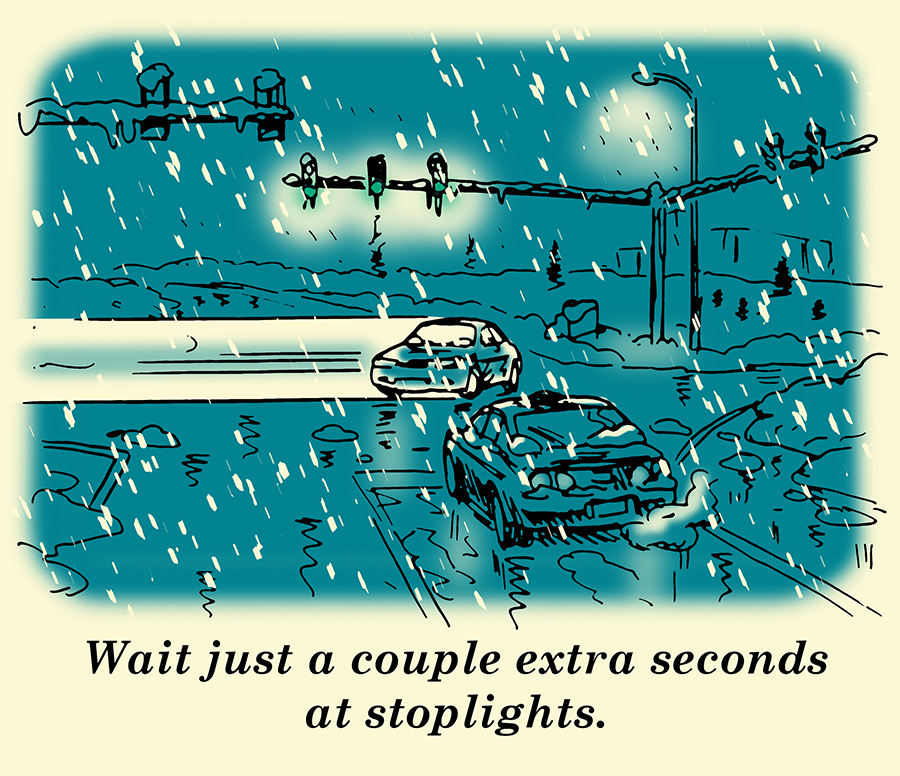
Give just a little extra time at stoplights. In snowy conditions, I always wait just an extra second or so to start going at a green light. You never know if someone from the other direction might slide or not be able to fully stop at their red light. Nobody is going to fault you for some extra caution in snowy conditions.
Give a little extra grace to other drivers. If you’re normally a little road-ragey, cool it. You should really cool it anyways, but especially in poor winter driving conditions. Give everyone around you plenty of space, don’t honk if someone doesn’t immediately hit the gas at a green light, etc. You’re not the only one stressed out about getting to work on time, but in the snow, there’s a little more slack all around, including, hopefully, from your employer.
Driving in wintry conditions can be hairy and stressful; you can find yourself gripping the steering wheel with white knuckles for hours on end. Hopefully by heeding the above tips, you can relax a little more (while staying vigilant) and will not only make it through that next snowstorm like a champ, but gain confidence in your winter driving skills as well, which is nearly half the battle.
Tags: Cars



